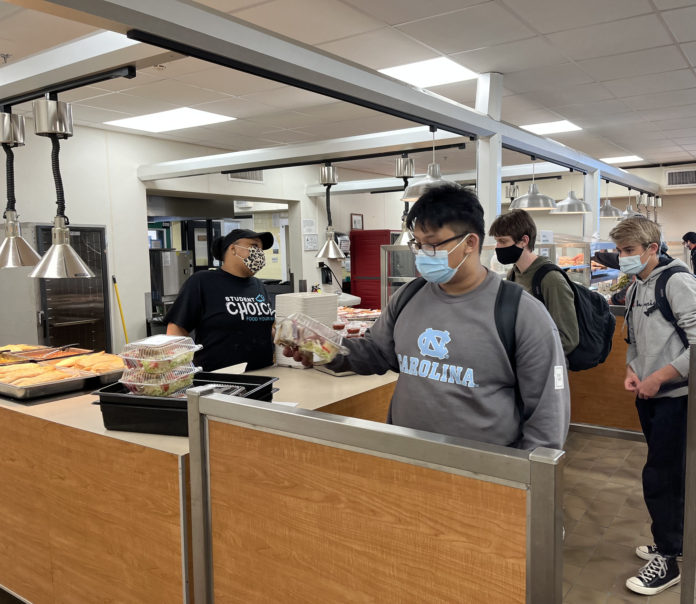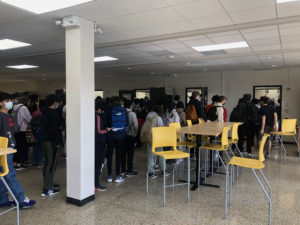
When Chapel Hill High School’s lunch bell rings at 12:35 every day, hundreds of students swarm the cafeteria, most standing close together, shoulder-to-shoulder, waiting eagerly in line for their food. Some students stick out by wearing their masks halfway down their faces or incautiously shoving themselves in the tight kitchen space to get their lunch as quickly as possible, making the lunch line an uncomfortable environment not just for their patient peers, but also the handful of cafeteria workers that serve them daily.
The people serving the food, the school’s cafeteria workers, are at risk of contracting COVID, as the omnicron variant is spreading through Chapel Hill High School at an alarming rate: in the past two weeks, Principal Charles Blanchard has reported in emails to students, staff and parents that there have been nearly 60 COVID cases at the school.
“It’s nerve wracking knowing there’s 60 bodies so close to me,” the cafeteria’s acting manager Nicole Rouse said. “I don’t know how many of those people actually have it or not, and COVID is now something I have to be constantly aware of when working and commuting.”
COVID fears aren’t the only factor making cafeteria workers’ jobs more difficult. The district has offered all students free lunches and breakfasts this school year, meaning the staff has been preparing and serving more food than ever before and, due to changes in COVID protocol, learning systems—hybrid, online and physical—and lunch schedules, the cafeteria staff has been constantly needing to adjust how they prepare and distribute food.
“[Free lunches have] definitely increased our numbers a lot,” Chapel Hill High School’s cafeteria manager Ashley Leaver said. “There’s a lot more kids eating than before, but it’s never felt like a burden. It’s just different because we aren’t used to serving this many students.”
Some students have begun eating more school lunches since they became free of cost, which adds to the number of students the staff has to feed.
“I started getting the school’s free lunches last year when they first started offering them,” sophomore Van Gaertner said. “Even though I would get school lunches when I was in middle school, I would also bring my own lunches: I definitely eat the school’s lunches more often now.”
When the current school year began, Chapel Hill High School was operating under a staggered lunch schedule, where students would remain in their fourth-period classes until their groups—numbered one through five—were called for their 20-minute eating period.
While many students complained about being unable to socialize with their friends in other classes, this system made cafeteria workers’ workloads easier to control. The staff was able to spend more time batch cooking, instead of preparing all the food at the same time, and had fewer leftovers because they were able to plan out more precisely how many servings were needed. The staggered lunch schedule also reduced the stress of keeping in order lines that are hundreds of hungry students long.
“There are so many students stealing food and putting them in their bookbags,” cafeteria worker Stephanie Tattis said. “We can’t control it either because we’re so short staffed. The food is free, but we need to serve everyone.”
Leaver has been working at the school for four years, through a company called Chartwells, a division of the multi-national foodservice company Compass Group PLC.

Leaver maintained her job as a cafeteria manager during the first semester of the 2020-2021 school year, despite the lack of students on campus, working to deliver lunches to students’ homes.
“We still had two kitchens open during the pandemic, so I actually managed the McDougle Middle School program for the year we were closed,” Leaver said. “We shipped out around 600 bagged meals every day on buses to 18 different apartment complexes and then the YMCA. We were still serving meals—just not in a cafeteria.”
Other members of Chapel Hill High School’s cafeteria staff weren’t able to hold onto their jobs at that time and experienced a stressful employment instability. Cafeteria worker Stephanie Tattis said all she was given a yes-or-no questionnaire as to whether she felt comfortable working as COVID was breaking out: that’s all she knew at the time.
“I really wanted to work but never got the call, so I went and got a part-time job,” Tattis said. “When you check ‘no,’ you don’t know how long that is.”
Once portions of the student body returned to the Chapel Hill High campus for hybrid learning in March 2021, the cafeteria had to prepare bagged lunches for each student. The extra preparation and distribution procedures, Leaver said, made the process lengthier and more difficult than when students would flock to the cafeteria to grab their own lunches.
On November 29, after a week-long Thanksgiving break, Chapel Hill High School’s lunch period was restored back to one period, removing the staggered release format used for the semester’s first few months.
Students generally seemed in favor of the change: seniors were given the ability to leave campus for lunch, the eating period was extended from 15 to 40 minutes and students were able to interact with their friends who may have been in different lunch periods previously.
But, for lunch workers, the change meant another overhaul to the logistics of lunch service, as well as an increased vulnerability of COVID infection.
“One thing I’ve noticed while serving lunches is that so many kids are right on top of each other maskless,” Rouse said. “I have to tell a few students every day ‘mask on please,’ but it’s hard to get them to listen.”
Rouse mentioned that if the staff is down a worker, it’s difficult for her team to serve students easily: they cannot afford to lose members for extensive periods of time. The possibility of contracting the virus is a fear that looms over the kitchen as students flood its doors.

Students at Chapel Hill High School have also become worried about how COVID can spread in crowded lines of students, noting that the process of getting food can be disorderly.
“People crowd the middle of lines and start new ones constantly, which is really concerning because a lot of students getting really close to others have their masks under their nose,” senior Snow Htoo said. “It’s very chaotic all the time; sometimes, they don’t even have enough food for all of us.”
Other students aren’t too concerned about COVID when in lines: they just want to get their food quickly so they can eat and socialize with their friends.
“I don’t really think about [COVID]: I’m just hungry,” sophomore Tyler Scialoia said.
Senior Min Thu added that students often take multiple lunches, making it difficult for all students to be served properly.
“The cafeteria workers have dealt with a lot of people going for seconds, or even third or fourth servings,” Thu said. “The cafeteria workers must be frustrated because other students don’t even get lunch.”
While the staff is having some difficulties managing troublesome students and lunch-line disorder, they think, with a little help from the school’s security guards, the crowd can be controlled.
“We need somebody here in the lunchroom to maintain the kids,” Tattis said. “When we’re short of a hand, we can’t watch or stop anybody that’s causing trouble: how can we tell kids to put back food they’re taking while trying to work at the same time?”
Rittis suggested that a security guard be stationed in the cafeteria, directing a few students at a time to get their food in an orderly fashion, making it easier for staff to serve them. However, Blanchard has started coming to the cafeteria often to make sure the lunch line is operating smoothly and everyone is following protocol.
“[Blanchard has] actually been really helpful as far as controlling the line and flow of students into the lunchroom,” Rouse said. “I want to give him a lot of credit because, at some places I worked, I hadn’t seen the principal for three years while I see him every single day.”
By supervising mask usage in the cafeteria and spreading out large groups of students, Blanchard has helped ease concerns over COVID contraction.
“I remind students to properly mask while they are in line waiting for food and remind them to mask back up once they are done eating,” Blanchard said. “Students have plenty of room in the cafeteria, behind the C to D building connector and in the courtyard to eat their lunch safely.”










